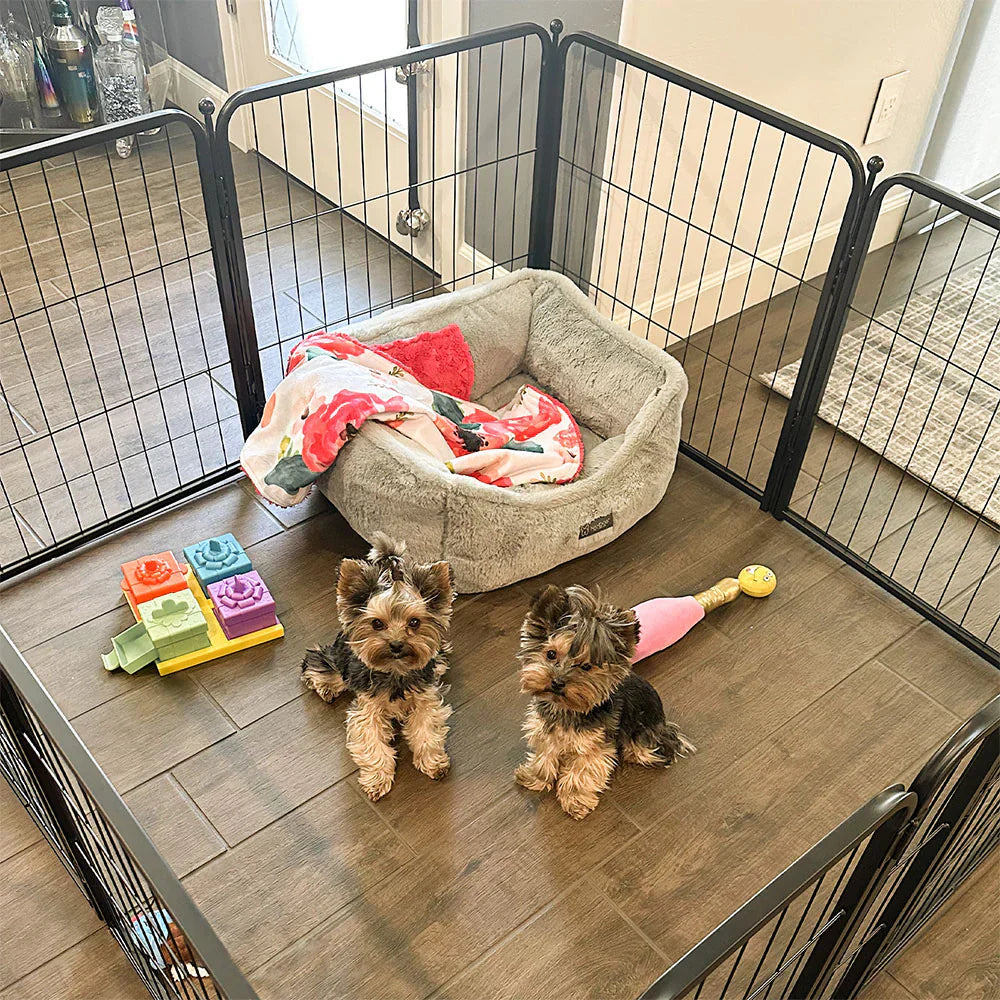1. The Great Puppy Escape
It’s a scene many new dog parents know too well. You set up a cute little playpen, add a comfy bed, a few toys, and think you’re ready. Ten minutes later, your puppy is standing proudly outside the pen, wagging their tail like they just won a gold medal.
Sound familiar? Puppies are curious explorers, and sometimes no fence seems high enough to contain their adventurous spirit. The good news is, with the right setup and approach, you can keep your pup safe, happy, and right where they should be.
In this guide, we’ll look at why puppies try to escape, how to make your pen escape-proof, and how to teach your dog to enjoy time inside it.
2. Why Puppies Try to Escape Their Playpen
According to the American Kennel Club (AKC), puppies do not escape to misbehave. They do it because of curiosity, separation anxiety, or boredom.
2.1 Curiosity:
Puppies explore the world with enthusiasm. They want to see, smell, and touch everything around them. Climbing or jumping is often just part of their natural discovery process.
2.2 Separation anxiety:
Young dogs feel anxious when they are away from their owners. When they cannot see you, they may panic and try to reach you. With proper training, a playpen becomes a place of comfort instead of stress. According to the AKC’s guide on helping puppies deal with separation anxiety, gentle exposure and positive reinforcement can help puppies feel more secure.
2.3 Boredom:
If a puppy has no toys or stimulation, they will find their own form of entertainment. Sometimes that means trying to escape the playpen or chewing on the panels.
Understanding the reason behind each behavior helps you choose the right solution. The goal is not just to block their way out but to make them want to stay inside.
3. The Design Matters: How to Choose an Escape-Proof Playpen
Not all playpens are created equal. The right design makes a huge difference in safety and peace of mind. Here’s what to look for:
-
Height: At least 30–40 inches for most breeds. Active jumpers or larger puppies may need taller panels.
-
Material: Heavy-duty steel or thick metal frames that don’t bend or wobble.
-
Secure latch: Choose pens with double-lock doors or slide bolts that puppies can’t nudge open.
-
Stable base: Make sure the pen doesn’t shift when your puppy jumps against it.
Some models, like the FXW playpen, are designed to stay steady both indoors and outdoors. Their reinforced panels and ground stakes prevent wobbling on grass, while rubber pads keep them quiet and stable on hard floors.
The result? A pen that stands strong even against your pup’s wildest zoomies.
4. Smart Setup Tips to Prevent Climbing

Even the best playpen can fail if it’s set up in the wrong spot. Here’s how to make your setup work:
-
Avoid furniture nearby. Puppies can use chairs, sofas, or curtains as “launch pads” to climb out.
-
Keep it visible. Place the pen where your dog can see the family - like the living room - so they don’t feel left out.
-
Make it cozy. Add a soft dog bed, blanket, and chew-safe toys. This turns the pen into a calm corner, not a punishment zone. (AKC)
-
Protect your floor. If your puppy’s pen is indoors, use waterproof flooring for puppy pens to keep messes contained and the area easy to clean.
Small details like these make a big difference in how your puppy feels about their space.
5. Behavior Training: Teaching Calm Inside the Pen
An escape-proof pen is not only about physical structure. Training plays a major role in helping your puppy stay calm.
Start with short sessions of five to ten minutes while you are nearby. Reward your puppy when they stay quiet or relaxed. Gradually increase the time as they become more comfortable.
The AKC recommends short, positive experiences to build confidence. This helps puppies associate the pen with safety instead of isolation.
If your puppy whines or cries, do not rush to open the door. Wait until they are calm before giving them attention or a treat. This teaches them that quiet behavior gets rewarded.
6. Common Mistakes to Avoid
Many dog parents unintentionally make playpen mistakes that lead to escapes or anxiety. Watch out for these:
-
Using a pen that’s too small for your puppy’s breed.
-
Letting your puppy out while they’re whining.
-
Skipping daily exercise before pen time.
-
Leaving the pen empty: no bed, toys, or stimulation.
If your puppy slides or pushes the pen, consider using a non-slip mat underneath. It not only stabilizes the setup but also protects your floors from scratches and spills.
7. From Escapes to Trust

The goal isn’t just to keep your puppy inside a fence to help them feel safe there.
Once your pup learns that the pen means rest, rewards, and comfort, it becomes a trusted space rather than a barrier.
As the AKC notes, structured boundaries help dogs grow calmer, more confident, and more secure.
So, the next time you see your puppy lying quietly in their pen, tail wagging softly, know that you’ve done more than stop an escape. You’ve created a safe zone built on trust.
Looking for a secure setup for your growing pup? Explore the FXW playpen collection trusted by thousands of dog parents for its strength, comfort, and flexibility.
FAQ: Escape-Proof Playpens for Puppies
Q1: How tall should a playpen be to stop my puppy from climbing out?
At least 30–40 inches for most small or medium breeds. For larger or more active puppies, go up to 48 inches.
Q2: How can I make my playpen more stable?
Use ground stakes outdoors or rubber pads indoors. Some pens, like the FXW Playpen, come with built-in stability features.
Q3: Should I leave my puppy in a playpen all day?
No. Puppies need social time and exercise. Use the playpen for short, supervised sessions throughout the day.
Q4: My puppy keeps crying in the playpen. What should I do?
Stay calm, ignore the whining, and reward quiet moments. Gradual training helps reduce separation anxiety.
Q5: What flooring is best under a puppy playpen?
Waterproof mats or vinyl sheets work best. They’re easy to clean and protect both your floors and your puppy’s paws.


Share:
Why Do Dogs Pee in Your Bed? Common Reasons and Solutions
Why Puppies Need Boundaries: The Psychology Behind Playpens